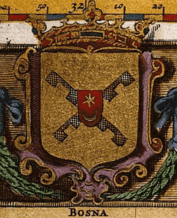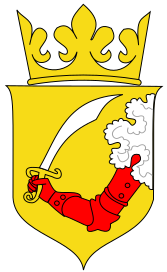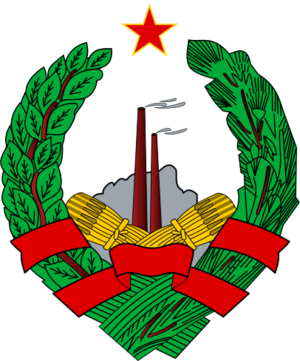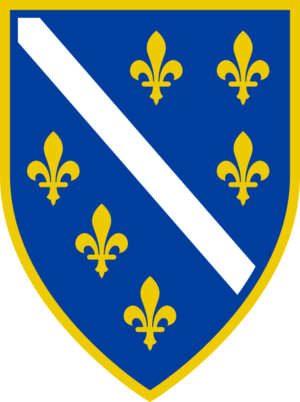Coat of arms of Bosnia and Herzegovina facts for kids
Quick facts for kids Coat of arms ofBosnia and Herzegovina |
|
|---|---|
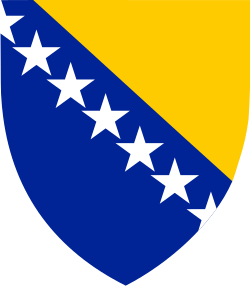 |
|
| Versions | |

The banner of arms, which serves as national flag
|
|
| Armiger | Bosnia and Herzegovina |
| Adopted | 18 May 1998 |
The coat of arms of Bosnia and Herzegovina was chosen in 1998. It replaced an older design used since 1992, when Bosnia and Herzegovina became an independent country. The new coat of arms looks like the national flag. Its three-pointed shield stands for the country's three main ethnic groups. It also hints at the shape of the country itself.
Contents
Exploring Bosnia's Historic Coats of Arms
What did early Bosnian coats of arms look like?
Some of the first coats of arms linked to Bosnia appear in the Fojnica Armorial. This old book was finished in the 1600s. The Fojnica arms show a gold shield with two black, rough staffs crossed over each other. Two "Moor's heads" are placed above each staff. On top of this is a red smaller shield, called an escutcheon. It has an eight-pointed star and a crescent moon. Over many centuries, European sources showed similar designs for Bosnia's coat of arms.
Symbols of the Bosnian Kings
The Kings of Bosnia ruled from 1377 to 1463. Their kingdom included parts of today's Bosnia-Herzegovina and Dalmatia. Their coat of arms had a blue shield with six Golden Lilies. These lilies were placed around a white diagonal stripe, called a bend. A gold border went around the whole shield. The Golden Lily is actually the Lilium bosniacum, a lily native to the area.
The top part of the royal coat of arms, called the crest, showed peacock feathers. These feathers sat inside a crown made of lilies. The House of Kotromanić was the royal family. Their rule ended in 1463 when the Ottoman Empire took over the region. After this, the royal coat of arms was no longer used in Bosnia. However, the symbols from these kings later inspired the coat of arms adopted in 1992. Old items suggest that the Lilium bosniacum has been a symbol for Bosnia since the 600s.
Bosnia under Austro-Hungarian Rule
In 1878, the Austro-Hungarian Empire took control of Herzegovina and Bosnia. Both regions then received their own coats of arms from the Empire. The design for Herzegovina was a red shield with a bare arm holding a broken spear. For Bosnia, the coat of arms was gold. It showed a red armored arm reaching out from clouds, holding a sword.
These designs were inspired by Stjepan Vukčić Kosača. He was a nobleman from the 1400s who ruled the region. His own coat of arms showed a red armored arm with a sword. It also had a red lion standing on its hind legs on a white shield. Even though both regions were part of the Hungarian crown, only Bosnia's coat of arms was included in the larger arms of the Hungarian Kings.
In the 1800s, people started to fight against both the old Ottoman rule and the new Austro-Hungarian control. This nationalist movement briefly brought back the old arms from the Fojnica armorial.
Bosnia's Communist Era Emblem
What did the socialist emblem look like?
The emblem of the Socialist Republic of Bosnia and Herzegovina was adopted on December 31, 1946. It was similar to the emblems of other Yugoslav republics. The design showed two crossed wheat stalks. In front of them was a picture of a neighborhood with two factory chimneys. Smoke was coming out of these chimneys.
A red ribbon wrapped around the wheat and branches. At the very top of the emblem was a red star with a golden border. This red star stood for the ideas of socialism and communism in Yugoslavia at that time.
What did the socialist emblem mean?
The emblem showed the importance of industry in Bosnia and Herzegovina. The factory chimneys represented the factories in several important Bosnian towns. These factories were very important for the economy. All the Yugoslav republics had similar emblems. However, Bosnia and Herzegovina was the only one that did not use national symbols. This showed that it was a country with many different ethnic groups.
This emblem was the first one in history that was specific to the entire modern country of Bosnia and Herzegovina.
Bosnia's Modern Coats of Arms
The 1992 Coat of Arms
The coat of arms for the Republic of Bosnia and Herzegovina was chosen on May 4, 1992. It looked a lot like the coat of arms of the Kotromanić royal family. It had a blue background with a white diagonal line. This line is called a "bendlet" in heraldry. The white diagonal line was meant to represent the sword of Tvrtko I. It also showed his strength as a ruler.
This coat of arms was designed very quickly. It was made right at the start of the Bosnian War, which lasted for three years. After the war ended, some groups, like the Bosnian Serbs, felt that the coat of arms only represented one ethnic group, the Bosniaks.
Why was the coat of arms changed in 1998?
To help solve this problem, the international community stepped in. In early 1998, a group was formed to change the flag. In the same year, the current coat of arms was adopted. This change was made to help reduce tensions among the different ethnic groups in the country.
Official Description of the Current Coat of Arms
The official description of the current coat of arms is:
The coat of arms of Bosnia and Herzegovina is blue. It has the shape of a shield with a pointed end. In the upper right corner of the shield, there is a yellow triangle. A row of white five-pointed stars runs parallel to the left side of the triangle.
See also
 In Spanish: Escudo de Bosnia y Herzegovina para niños
In Spanish: Escudo de Bosnia y Herzegovina para niños
- Coat of arms of Herzeg-Bosnia
- Coat of arms of the Federation of Bosnia and Herzegovina, for the sub-national entity's coat of arms
- Seal of Republika Srpska, for the sub-national entity's emblem




